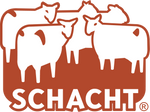
Beth Smith and Jillian Moreno live about 30 minutes from each other and spend a lot of spinning time together, trading ideas and cheering each other on. Recently, the two have found weaving sneaking into their thoughts more and more. “Wouldn’t it be fun,” they said, “to do a project where we spin our yarn and weave it and see what happens?” “Yes!” they said, “that sounds like an awesome plan.” We thought so, too. Through the end of the year, they will post on the Schacht Spindle blog, telling you about their journey weaving with handspun on a rigid heddle loom.
Beth
Finally! The skirt, she is finished.
Since we last talked, I sent my sewn-together skirt from Michigan to Maine to the expert dyeing fingers of Amy King, owner of Spunky Eclectic. We chatted about color and what I would like and, to everyone’s surprise, I chose neither pink nor orange. Instead, it was chocolate brown. I do love chocolate.
I actually sent the skirt just when the six main pieces were assembled, before lining or hemming I was interested in how the fabric would hold up with raw edges and another dip and wring before completing the project. If I saw any changes in the fabric after dyeing, I would know that my finishing would have been incomplete and the fulling should have been longer. I was thrilled, though, that the fabric held together with a minimum of fraying. It also held its shape extremely well, no sagging or stretching. Everything was fine!
So here she is:

This was a great project that was filled with a lot of discoveries, and some things that were harder than I thought they would be.
Here’s what I learned:
- Making skirts takes a ton of yarn – but it hasn’t stopped me from making more.
- Finished handwoven fabric, specifically wool, stands up to some tough processes, like dyeing.
- Weaving fine yarns on a rigid heddle loom takes some time.
- Rigid heddle fabric is just as beautiful, durable, and drapey as fabric woven on a floor loom.
What I would do differently next time:
- I would wind my warp chains with fewer ends in each. (Remember I couldn’t do direct warping because my warp was 6 yards long.)
- I would realize that rigid heddle weaving is a bit slower than on a floor loom and be less frustrated with the time it took. (I think in the end it was about twice as long on the rigid heddle if we compare the same yardage.)
Overall, I have been encouraged to continue weaving cloth with fine yarns for clothing, and I have a bunch of new ideas. If you want to follow along with my progress on these new ideas you can check me out on my personal website at bethsmithtextiles.com
Jillian
Today it’s time for the big reveal!
When last we checked in, I had cut and edge-stitched my fabric and did some preliminary hand stitching to hold it all together.
Since then I’ve embroidered more and thought about what my next project will be!
I embroidered some swoopy bits on the edges in chain stitch. I like how the work with the stitching that holds the piece together.

I listened to the Woolful podcast interview with Tif Fussell (Dottie Angel) and was inspired to add one of her signature embroidered wooly tattoos to my piece.

I still may add more stitching to it. I consider everything I stitch on to be a work in progress pretty much forever. It’s really easy to stitch on hand woven cloth.
But I like how the stitching looks right now, too.

I’ve worn my wrap a lot - it’s cozy and handsfree, adjusting-wise, once I get it on.
Here’s how it looks with the twist in the front and in the back. I like it equally both ways.


What I learned from this project:
- I can cut handwoven fabric and not die; it is as easy as everyone says.
- Handspun yarn is amazing handwoven; my BFL woven is soft, light, and fluid.
- I really like rigid heddle weaving and want to do more; it’s so straight-forward and the math is pretty easy.
What I’ll do differently next time:
- Sample. I threw caution to the wind this time, but next time I’m going to sample. I’ll make sure that I have enough fiber to do at least 2 or 3 samples before diving into the project.
- Neater edges. The edges really bug me. I’ll probably hem the fabric or use rows of zig zag stitch close together
- More embroidery, though I’ll probably add more to this one still.
What I’m curious about now:
- How to sample efficiently, so I get the info I need and don’t spend all of my weaving time or hand dyed fiber on the sampling.
- Using different-sized and textured yarns in weaving.
- Color in weaving, particularly using variegated hand-dyed fiber. My stash is overrun with it.
- Making more of these type of wraps, but maybe something that resembles a jacket too.
I want to say a huge thank you to Schacht for letting Beth and I play on their blog. To Benjamin for being so enthusiastic and dream to work with. To Jane for saying yes to the idea and always being such a champion of creative hand weaving.
And to Beth for never letting me sit with the covers over my head for too long when I was chicken to do something.

